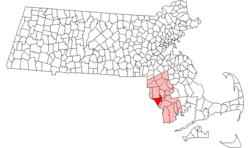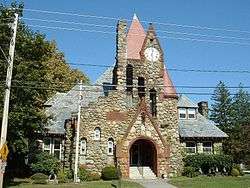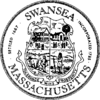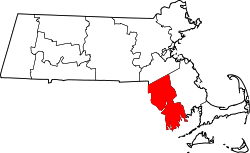Swansea, Massachusetts
| Swansea, Massachusetts | ||
|---|---|---|
| Town | ||
|
Swansea Town Hall | ||
| ||
 Location in Bristol County in Massachusetts | ||
| Coordinates: 41°44′53″N 71°11′25″W / 41.74806°N 71.19028°WCoordinates: 41°44′53″N 71°11′25″W / 41.74806°N 71.19028°W | ||
| Country | United States | |
| State | Massachusetts | |
| County | Bristol | |
| Settled | 1667 | |
| Incorporated | 1667 | |
| Government | ||
| • Type | Open town meeting | |
| Area | ||
| • Total | 25.5 sq mi (66.1 km2) | |
| • Land | 23.1 sq mi (59.7 km2) | |
| • Water | 2.5 sq mi (6.4 km2) | |
| Elevation | 22 ft (7 m) | |
| Population (2010) | ||
| • Total | 15,865 | |
| • Density | 620/sq mi (240/km2) | |
| Time zone | Eastern (UTC-5) | |
| • Summer (DST) | Eastern (UTC-4) | |
| ZIP code | 02777 | |
| Area code(s) | 508 / 774 | |
| FIPS code | 25-68750 | |
| GNIS feature ID | 0619439 | |
| Website | www.town.swansea.ma.us | |
Swansea is a town in Bristol County in southeastern Massachusetts. It is located at the mouth of the Taunton River, just west of Fall River, 47 miles (76 km) south of Boston, and 12 miles (19 km) southeast of Providence, Rhode Island. The population was 15,865 at the 2010 census.[1]
The villages of Hortonville, Barneyville and Ocean Grove are located in the town.
History
Swansea was named for the Welsh city of Swansea, which had been the hometown of some original settlers. John Miles, the founder of the first Baptist Church in Wales, moved to Swansea in 1662/3.[2] William Brenton had purchased the land from Native Americans. Parts of its territory were originally part of Rehoboth, Massachusetts.
In 1667 the first Baptist church in Massachusetts relocated to Swansea from Rehoboth after experiencing religious intolerance there, and Swansea was incorporated as an independent town.
On June 20, 1675, the first Indian attack of King Philip's War had all 70 settlers confined to their stockade. By June 25 the entire town had been burned, although a handful of the colonists escaped to Taunton. When the active war ended in 1676, the town was soon rebuilt.
After the war, many small industries, such as forges, ironworks and fisheries, opened up in the town. Many would later leave, and there remains a large agricultural sector.
What is now Barrington, Rhode Island (part of Massachusetts until 1747) was separated from the rest of Swansea in 1717, over religious differences.[3]
In the late 1890s, trolleys connected the town to Providence, Fall River and Taunton, and the town has retained a suburban residential feel. Today Swansea is well known for its retail areas.[4]
Swansea gained national attention in 1985 when Mark Hoyle, a young hemophiliac who had contracted AIDS through a blood transfusion, was allowed to attend public schools. It was the first time in the U.S. that a student known to have the disease was allowed to enter public schools.[5] The case came to national attention around the same time as that of Ryan White in Indiana, and helped many children with HIV attend schools throughout the country. Hoyle died one year later, and a new elementary school was named in his honor.
Geography
The town has a total area of 25.5 square miles (66 km2), of which 23.1 square miles (60 km2) is land and 2.5 square miles (6.5 km2), or 9.67%, is water. The town is bordered by Dighton on the northeast, Somerset on the east, Mount Hope Bay on the south, Warren, Rhode Island, on the southwest, Barrington, Rhode Island, on the west, and Seekonk and Rehoboth to the north. Part of the town's border with Somerset is made up of the Lees River. The Cole, Kickamuit and Palmer rivers also pass through the town on their way south to Mount Hope Bay (for the Kickamuit, Cole and Lees rivers) and Narragansett Bay (for the Palmer). The entire town is a part of the Narragansett Bay watershed area. The town's neighborhoods include Barneyville, North Swansea, Swansea Village, Birch Swamp Corner, Hortonville, Luther Corner, South Swansea, Touissett, Ocean Grove, and Smokerise. Swansea is 12 miles (19 km) southeast of Providence and 47 miles (76 km) south of Boston.
Much of the town's retail businesses are located along the highways, with the area around the junction of U.S. Route 6 and Massachusetts Route 118 being the location of Swansea Mall, a large single-level mall that is the center of the retail district. Just north of the mall are several office complexes, including the former headquarters of the First Federal Bank (now a division headquarters for Webster Bank, which bought it out), doctor's offices and Academic Management Services, a division of Sallie Mae. The area along Route 103 between the Lees River and the Cole River is also an area for retail, with many smaller businesses lining the road.
However, outside of the retail area (as well as the densely populated neighborhoods of Ocean Grove, South Swansea and Smokerise), much of the area is rural.
Demographics
| Historical population | ||
|---|---|---|
| Year | Pop. | ±% |
| 1850 | 1,554 | — |
| 1860 | 1,430 | −8.0% |
| 1870 | 1,294 | −9.5% |
| 1880 | 1,355 | +4.7% |
| 1890 | 1,456 | +7.5% |
| 1900 | 1,645 | +13.0% |
| 1910 | 1,978 | +20.2% |
| 1920 | 2,334 | +18.0% |
| 1930 | 3,941 | +68.9% |
| 1940 | 4,684 | +18.9% |
| 1950 | 6,121 | +30.7% |
| 1960 | 9,916 | +62.0% |
| 1970 | 12,640 | +27.5% |
| 1980 | 15,461 | +22.3% |
| 1990 | 15,411 | −0.3% |
| 2000 | 15,901 | +3.2% |
| 2010 | 15,865 | −0.2% |
Source: United States Census records and Population Estimates Program data.[6][7][8][9][10][11][12][13][14][15] | ||
As of the census[16] of 2000, there were 15,901 people, 5,888 households, and 4,539 families residing in the town. The population density was 689.4 people per square mile (266.2/km²). There were 6,070 housing units at an average density of 263.2 per square mile (101.6/km²). The racial makeup of the town was 97.91% White, 0.38% African American, 0.08% Native American, 0.36% Asian, 0.01% Pacific Islander, 0.27% from other races, and 1.00% from two or more races. Hispanic or Latino of any race were 0.60% of the population.
There were 5,888 households out of which 31.1% had children under the age of 18 living with them, 64.6% were married couples living together, 8.8% had a female householder with no husband present, and 22.9% were non-families. 19.6% of all households were made up of individuals and 10.2% had someone living alone who was 65 years of age or older. The average household size was 2.67 and the average family size was 3.06.
In the town the population was spread out with 22.2% under the age of 18, 6.7% from 18 to 24, 28.4% from 25 to 44, 27.0% from 45 to 64, and 15.7% who were 65 years of age or older. The median age was 40 years. For every 100 females there were 96.9 males. For every 100 females age 18 and over, there were 92.3 males.
The median income for a household in the town was $52,524, and the median income for a family was $60,567. Males had a median income of $40,056 versus $27,072 for females. The per capita income for the town was $21,776. About 3.4% of families and 4.9% of the population were below the poverty line, including 2.9% of those under age 18 and 11.0% of those age 65 or over.
Government
On the state level, Swansea is a part of two state representative districts, the Fourth Bristol (including Rehoboth, Seekonk and part of Norton, Rep. Steve Howitt) and Fifth Bristol (including Dighton, Somerset and part of the city of Taunton, Rep. Patricia Haddad). The town is part of the First Bristol and Plymouth state senatorial district, which includes the communities of Fall River, Freetown, Lakeville, Rochester, Somerset and Westport, currently Senator Michael Rodrigues (D-Westport) represents Swansea. Swansea is patrolled by Troop D (Southeast District), 3rd (Dartmouth) Barracks of the Massachusetts State Police. On the national level, the town is part of Massachusetts's 4th congressional district, which is represented by Joseph Kennedy III. The state's senior Senator is Elizabeth Warren and the state's junior Senator is Edward Markey.
The town is governed by Selectmen and an Administrator. Swansea also maintains the tradition of open Town Meetings. As of 2001, total property values are assessed at $980 million, and property taxes amount to $15 million. The town operates on a budget of approximately $10 million, which does not include another $13.5 million spent on schools.
The town has four fire stations (the Central station being in South Swansea, with branch stations in North Swansea, Central Swansea and Ocean Grove),[17] one library, a single police station, and a new post office. The town has two playgrounds, as well as a town beach with a picnic area (near the mouth of the Cole), and the town conservation farm.
Selectmen
- Scott Ventura - Chairman
- Robert Marquis - Vice-Chairman
- Christopher R. Carreiro - Clerk
Education
Secondary
The Swansea Public Schools serve the town, with four elementary schools (Joseph G. Luther Elementary School at Luther's Corner, Gardner Elementary School in the South Swansea-Ocean Grove neighborhood, Elizabeth S. Brown Elementary School near the town center, and Mark Hoyle Elementary School in North Swansea), as well as Joseph Case Junior High School and Joseph Case High School, both located in the town center. Case High School (as it is commonly known) has the school colors of maroon and gold, and its mascot is the Cardinal. High school students also have the option of attending Diman Regional Vocational Technical High School in Fall River, or Bristol County Agricultural High School in Dighton.
There are two Christian schools in town, and there are also local Catholic schools in nearby Warren and Fall River.
School Committee members
- Christopher R. Carreiro
- James Carvalho
- Joseph D. Salpietro III - Chairman
- Eric C. Graham - Vice-Chairman
- Dr. A. Keith Carreiro -
- Ronald Silva- Swansea Representative, Diman School Committee
Post-secondary
Eastern Nazarene College offers Adult Studies/LEAD classes in Swansea.[18]
Transportation
The town is bisected by Interstate 195, U.S. Route 6, and state routes 103, 118 and 136. Swansea has two exits off I-195 serving the town, Exit 2 (Route 136) and 3 (Route 6 to Route 118). In addition, Exit 4 (Route 103) in Somerset provides quick access to the Ocean Grove neighborhood.
Swansea is the western terminus of the Southeastern Regional Transit Authority (SRTA) bus line. Regional bus service can be reached in Fall River, and the nearest regional rail service is in Providence. The nearest national airline service can be reached at T. F. Green Airport in Rhode Island, and international service can be reached at Logan International Airport in Boston.
Points of interest
- Martin House Farm (1728), G.A.R. Highway, North Swansea
- J.G. Luther Museum (home of the Swansea Historical Society), Old Warren Rd. (intersection of Maple Avenue and Pearse Road)
- Simcock House, 1074 Sharps Lot Road
- Canyon; Burnside Dr.
- The Ice Cream Barn at Baker Farm, 89 Locust Street
Notable people
- Benjamin Brown (politician), member of the United States Congress; born in Swansea.[19]
- Oliver Chace, founder of what is today Berkshire Hathaway; born in Swansea.[20]
- Warren A. Cole, founder of Lambda Chi Alpha fraternity
- The Cowsills, a family band from the 1960s
- Bob Evans, professional wrestler and trainer
- Jason Roy, Big Brother 17 houseguest and runner-up on Big Brother: Over The Top
- Cheryl Wheeler, folk singer and songwriter
- Thomas Willett, first Mayor of New York City
References
| Wikimedia Commons has media related to Swansea, Massachusetts. |
- ↑ "Profile of General Population and Housing Characteristics: 2010 Demographic Profile Data (DP-1): Swansea town, Massachusetts". U.S. Census Bureau, American Factfinder. Retrieved December 6, 2011.
- ↑
- ↑ Barrington - History
- ↑ SwanseaMass.org - History
- ↑ "Schools poised to adopt official policy on HIV", Providence Journal, 14 Jan 2004.
- ↑ "TOTAL POPULATION (P1), 2010 Census Summary File 1". American FactFinder, All County Subdivisions within Massachusetts. United States Census Bureau. 2010.
- ↑ "Massachusetts by Place and County Subdivision - GCT-T1. Population Estimates". United States Census Bureau. Retrieved July 12, 2011.
- ↑ "1990 Census of Population, General Population Characteristics: Massachusetts" (PDF). US Census Bureau. December 1990. Table 76: General Characteristics of Persons, Households, and Families: 1990. 1990 CP-1-23. Retrieved July 12, 2011.
- ↑ "1980 Census of the Population, Number of Inhabitants: Massachusetts" (PDF). US Census Bureau. December 1981. Table 4. Populations of County Subdivisions: 1960 to 1980. PC80-1-A23. Retrieved July 12, 2011.
- ↑ "1950 Census of Population" (PDF). Bureau of the Census. 1952. Section 6, Pages 21-10 and 21-11, Massachusetts Table 6. Population of Counties by Minor Civil Divisions: 1930 to 1950. Retrieved July 12, 2011.
- ↑ "1920 Census of Population" (PDF). Bureau of the Census. Number of Inhabitants, by Counties and Minor Civil Divisions. Pages 21-5 through 21-7. Massachusetts Table 2. Population of Counties by Minor Civil Divisions: 1920, 1910, and 1920. Retrieved July 12, 2011.
- ↑ "1890 Census of the Population" (PDF). Department of the Interior, Census Office. Pages 179 through 182. Massachusetts Table 5. Population of States and Territories by Minor Civil Divisions: 1880 and 1890. Retrieved July 12, 2011.
- ↑ "1870 Census of the Population" (PDF). Department of the Interior, Census Office. 1872. Pages 217 through 220. Table IX. Population of Minor Civil Divisions, &c. Massachusetts. Retrieved July 12, 2011.
- ↑ "1860 Census" (PDF). Department of the Interior, Census Office. 1864. Pages 220 through 226. State of Massachusetts Table No. 3. Populations of Cities, Towns, &c. Retrieved July 12, 2011.
- ↑ "1850 Census" (PDF). Department of the Interior, Census Office. 1854. Pages 338 through 393. Populations of Cities, Towns, &c. Retrieved July 12, 2011.
- ↑ "American FactFinder". United States Census Bureau. Retrieved 2008-01-31.
- ↑ http://swanseafd.com
- ↑ "ENC's Adult and Graduate Studies Program expands into satellite locations around the state". Nazarene Communications Network. December 18, 2008.
- ↑ "BROWN, Benjamin, (1756 - 1831)". Biographical Directory of the United States Congress. Retrieved September 29, 2012.
- ↑ "Oliver Chace". Find A Grave. Retrieved September 29, 2012.
Further reading
- History of Swansea, Massachusetts, 1667-1917, by Otis Olney Wright


